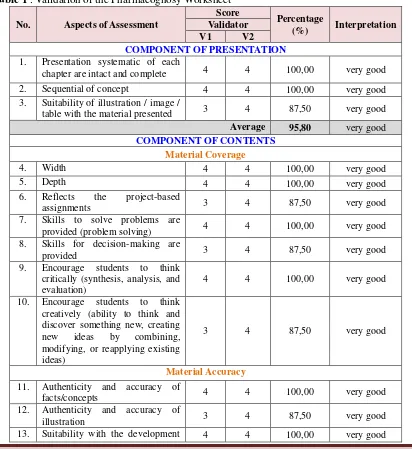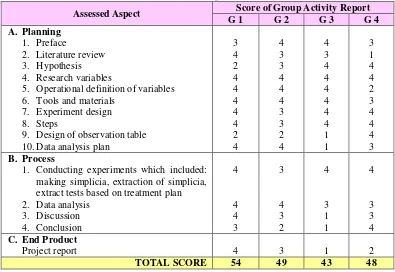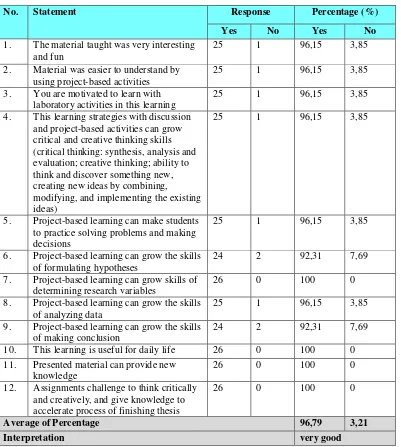BE-27
DEVELOPMENT OF PROJECT-BASED WORKSHEET OF
PHARMACOGNOSY TO FACILITATE CRITICAL AND CREATIVE
THINKING IN BIOLOGY STUDENT
Evie Ratnasari, Yuliani, Yuni Sri Rahayu
Biology Department, Faculty of Mathematics and Natural Science, State University of Surabaya
Abstract
The purpose of this study was to produce project-based worksheet of Pharmacognosy which can facilitate students of Biology Department, Faculty of Mathematics and Natural Science Unesa to think critically and creatively, and to describe the effectiveness of the worksheet empirically.This study was a developmental research which followed the phases of Analysis, Planning, Design, Development and Implementation. Evaluation and Revision were conducted in each phase. The step carried in this study was analysis of Pharmacognosy course curriculum for undergraduate Biology student in Faculty of Mathematics and Natural Science, Unesa. Planning of form and substance of the worksheet was done in planning phase, draft of worksheet was prepared during design phase, then review and validation of the draft were conducted by education expert and Pharmacognosy expert in the development phase. The worksheet then assigned (implementation) limitedly to Biology students to obtain performance assessment and legibility response.Result of the study was project-based worksheet of Pharmacognosy which stated as feasible theoretically and empirically. Theoretical feasibility was taken from validation assessment of worksheet with 94.60% average percentage and very good interpretation, whereas the empirical feasibility was taken from: a) score of project report assessments which ranged from 43 to 54 (grade ranged from 71.67 to 90.00: critical and creative to very critical and creative); and b) student response with 96.60% average percentage and very good interpretation.
Keywords: Development, Pharmacognosy, Project-based Worksheet, Critical and Creative Thinking
INTRODUCTION
Pharmacognosy is one of selective courses conducted in each semester which can be programmed by students majoring in Biology, Surabaya State University. This course is intended for student in 5th and 6th semester and weight 2/1 credits, which means 2 credits for the course and 1 credit for the laboratory activity.
able to think critically and creatively, and accelerate the process of finishing the thesis.
Since this course was first conducted, student interest to conduct research focusing in secondary metabolites were increased, therefore theimprovement of learning process in this course is needed. In teaching and learning process, Pharmacognosy team has provided textbook and learning set consist of Syllabus, Lesson Plan, and Worksheet, although it is still in simple form. Remembering student interest in researching secondary metabolism and the support of this course to finish thesis, Pharmacognosy team tried to give assignment that would challenge them to think critically and creatively. The appropriate learning to facilitate it is Project-Based Learning (PBL).
PBL is a systematic teaching method that involves learners in learning complex knowledge and skills, authentic questions, product and task design. Learners are capable of critical and creative thinking by developing initiatives. Creativity of the project fosters individual growth. In project-based learning, learners are involved in solving the problems assigned, allowing the learner to actively build and manage learning, and create a realistic student. This learning method uses problems as a first step in collecting and integrating new knowledge based on their experiences in real activity. PBL is designed for use on complex issues that required learners in investigating and understanding. Based on earlier research, PBL provides cognitive abilities and motivation that result in improved learning and better ability to retain and to apply knowledge. Learning tool required in PBL is in form of Student Worksheet that is able to evoke the process of critical thinking and creative thinking which is the highest level of thinking skill.
Thinking skills are classified into basic thinking skills and higher order thinking skills. Costa (1985) stated that the basic thinking skills include qualifications, classification, relationship variables, transformation, and a causal relationship, while the higher order thinking skills include problem solving, decision making, critical thinking, and creative thinking. Based on these descriptions, the researchers wanted to develop worksheets that can train students to think critically and creatively. The purpose of this study is to describe the feasibility of the project based Pharmacognosy worksheet that can train students to think critically and creatively and to describe the effectiveness of the worksheet empirically.
RESEARCH METHOD
BE-29
the draft of worksheet. Data analysis was conducted using qualitative descriptive analysis technique and quantitative data analysis technique. Worksheet can be declared as eligible if the value was 70.0 % with good interpretation. Report of project-based activity that was done by the student can be declared included intraining to think critically and creatively if the score 42 with critical and creative interpretation.
RESULT AND DISCUSSION
Based on the study, project-based worksheet of Pharmacognosy which can train students of Biology Department to think critically and creatively was successfully produced.Validation was done by two validators from education experts and biologist related to Pharmacognosy. Following are the review of Pharmacognosy worksheet as stated in Table 1.
Table 1 . Validation of the Pharmacognosy Worksheet
No. Aspects of Assessment
Score
Percentage
(%) Interpretation Validator
V1 V2
COMPONENT OF PRESENTATION
1. Presentation systematic of each
chapter are intact and complete 4 4 100,00 very good
2. Sequential of concept 4 4 100,00 very good
3. Suitability of illustration / image /
table with the material presented 3 4 87,50 very good Average 95,80 very good
COMPONENT OF CONTENTS Material Coverage
4. Width 4 4 100,00 very good
5. Depth 4 4 100,00 very good
6. Reflects the project-based
assignments 3 4 87,50 very good
7. Skills to solve problems are
provided (problem solving) 4 4 100,00 very good
8. Skills for decision-making are
provided 3 4 87,50 very good
9. Encourage students to think critically (synthesis, analysis, and evaluation)
4 4 100,00 very good
10. Encourage students to think creatively (ability to think and discover something new, creating new ideas by combining, modifying, or reapplying existing ideas)
3 4 87,50 very good
Material Accuracy
11. Authenticity and accuracy of
facts/concepts 4 4 100,00 very good
12. Authenticity and accuracy of
illustration 3 4 87,50 very good
No. Aspects of Assessment
Score
Percentage
(%) Interpretation Validator
V1 V2
of science and technology
14. Authenticity and accuracy of
procedure 4 4 100,00 very good
Average 95,50 very good
COMPONENT OF DISCUSSION AND READABILITY Suitability with Student Development
15. Kesesuaiandengantingkatperkemb
anganberpikirpengguna 4 4 100,00 very good
16. Kesesuaiandenganperkembangans
osio-emosionalpengguna 4 4 100,00 very good
Language
17. Keterpahamanbahasa 3 4 87,50 very good
18. Kesesuaianpenggunaanperistilaha
ndalambahasa 3 4 87,50 very good
19. Pesan yang
disampaikanjelasdanmudahdipaha mi
3 4 87,50 very good
Average 92,50 very good
Total Score 68 76
Average 94,60 very good
Description of Validator
Validator 1 (V1) = Expert of education
Validator 2 (V2) = Expert of Pharmacognosy subject
Description of Scoring Extremely less = 1 Less = 2
Good = 3
Very good = 4
Based on the validation results of worksheet as showed in Table 1, it was indicated that the assessment of both validators get a percentage of the average value of 94.60 % with a very good interpretation. Based on Table 1, it was showed that the average percentage of assessment component was above 95.00% except the language and readability were only 92.50 %. This shows that in terms of presentation (system, sequential, and suitability of pictures), content (coverage and accuracy of the material) and the language contained in the worksheet was very good and usable.
Student Worksheet included project-based assignments that can train students to solve problems (problem solving), critical thinking (synthesis, analysis, and evaluation) with a percentage of 100% , as well as to train creative thinking (the ability to think and discover something new, creating new ideas by combining, modifying, or reapplying existing ideas) with percentage of 87.50%.
BE-31
advanced scientific methods; while for the creative thinking, researchers highlighted the ability of students to get creative ideas and innovation to be able to solve problems. The short lecture meeting constraints often led to critical and creative thinking skills in students.
Based on the results of the validation and revision, the worksheet then tested limitedly to students which programmed Pharmacognosy course. The result of the project reports was contained in Table 2 below.
Table 2. Data of Student Laboratory Activity Report
Assessed Aspect Score of Group Activity Report
G 1 G 2 G 3 G 4
A. Planning 1. Preface
2. Literature review 3. Hypothesis 4. Research variables
5. Operational definition of variables 6. Tools and materials
7. Experiment design 8. Steps
9. Design of observation table 10. Data analysis plan
1. Conducting experiments which included: making simplicia, extraction of simplicia, extract tests based on treatment plan 2. Data analysis
Project assessment carried out starting from the planning, construction process, until the final result of the project. Therefore researchers need to apply the things or steps that need to be assessed. In terms of project report on this test were assessed are creative ideas in problem solving solution preparation, experimental design, experiment for data collection, data analysis, and submission of written reports.
Based on the data in Table 3, it showed that the first group got the highest report score, that was 54, while the other groups got a score < than 54, those were group 2,3, and 4. All four groups received a score 42 with critical and creative interpretation (value ranged from 71.67 to 90.00: critical and creative to very critical and creative). This showed that the four groups hadbeen trained critical and creative thinking skills by working on the worksheet.
Table 3.Result of Student Response
No. Statement Response Percentage (%)
Yes No Yes No
1. The material taught was very interesting and fun
25 1 96,15 3,85
2. Material was easier to understand by using project-based activities
25 1 96,15 3,85
3. You are motivated to learn with laboratory activities in this learning
25 1 96,15 3,85
4. This learning strategies with discussion and project-based activities can grow critical and creative thinking skills (critical thinking: synthesis, analysis and evaluation; creative thinking; ability to think and discover something new, creating new ideas by combining, modifying, and implementing the existing ideas)
25 1 96,15 3,85
5. Project-based learning can make students to practice solving problems and making decisions
25 1 96,15 3,85
6. Project-based learning can grow the skills of formulating hypotheses
24 2 92,31 7,69
7. Project-based learning can grow skills of determining research variables
26 0 100 0
8. Project-based learning can grow the skills of analyzing data
25 1 96,15 3,85
9. Project-based learning can grow the skills of making conclusion
24 2 92,31 7,69
10. This learning is useful for daily life 26 0 100 0 11. Presented material can provide new
knowledge
26 0 100 0
12. Assignments challenge to think critically and creatively, and give knowledge to accelerate process of finishing thesis
26 0 100 0
Average of Percentage 96,79 3,21
Interpretation very good
Based on the data listed in Table 3, the average percentage of student responses was 96.79 % with a very good interpretation. Students responded positively to the learning activities carried out using project-based assignment and 3.21 % of students respond negatively to the learning. Students found that discussion and project-based activitycan grow critical and creative thinking skills (critical thinking: synthesis, analysis, and evaluation; creative thinking: ability to think and discover something new, creating new ideas by combining, modifying,and implementingexisting ideas). Besides, learning becomes more interesting and students become motivated.
BE-33
orientation of the problem (there are cases in the community), reviewing the literature as the basis for determining the hypothesis, creating mew idea as creative solutions to solve problems, design experiments, carry out experiments, write up the results experiments in the table, analyze data, and formulate conclusions. Students were also asked to produce scientific papers and literature-based experiments based on the rules of scientific writing. With the use of the scientific method in practical activities, students would be able to think critically and creatively and to provide insight to accelerate the completion of their thesis. At the time of project planning, student develop creative abilities (Marzano, 1988). Project Based Learning is centered on student and provides an opportunity to conduct an investigation on a specific topic deeply. Students are more autonomous when they built independently significant evidence that shows learning (Grant, 2002). The same statement also expressed by Barron (1998), PBL is a constructive learning to explore deeper learning using research-based approach to solve real and relevant problems to their daily lives. PBL methods matchedto the concept of educational innovation, especially in terms of acquiring basic knowledge (basic sciences) which are useful to solve the problems encountered. Students learn actively and independently in integrated subjects (Pharmacognosy, plant physiology, biochemistry, plant disease, microbiology) and relevant to the actual reality.
It was the goal of this research is to carry out the Project-Based Learning as a strategyto develop embryo inside the student to be honest, open, objective, have a commitment to the purity and accuracy. These attitudes need to be trained and owned by students. In addition, by producing project-based Pharmacognosy worksheet, hopefully this would be applicable for both lecturers and students due to passing series of reviews and tests. This Pharmacognosy worksheet could train students to think critically and creatively and could be used to solve issues in the society, and the results of the project can be used by students as their thesis object. It was expected for this worksheet to contribute to the increase of professional competence of students.
CONCLUSION AND SUGGESTION
This study resulted in a project-based Pharmacognosy worksheet that can facilitate critical and creative thinking, which stated as feasible theoretically and empirically. Theoretical feasibility was obtained from assessment validation average percentage as 94.60% with very good interpretation. While the empirical feasibility was obtained from project report assignmentwith score ranged from 43 to 54 (value ranged from 71.67 to 90.00: critical and creative to very critical and creative), and the results of student responses which got average percentage of 96.60% with very good interpretation.
REFERENCES
Berg, K.E. & Latin, R.W. 2008. Essentials of Research Methods in Health, Physical education, Exercise Science, and Recreation. Philadelphia: Wolter Kluwer Lippincott Williams & Wilkins
Costa, A. L., dan Marzano, R. 1987. Teaching the Language of Thinking. Educational Research (October, 1987): 29-33
Fenrich, P. 1997. Practical Guidelines for Creating Instructional Multimedia Applications.Fort Worth: The DrydenPressHarcourtBraceCollege Publishers.
Fisher, A. 2001.Critical Thinking: An Introduction. Cambridge: CambridgeUniversity Press Fraenkel, J.R., &Wallen, N.E. 1993. How to Design and Evaluate Reseach in Education.New
Grant, M.M. 2002. Getting A Grip on Project Based Learning: Theory, Cases andRecommendation. Meridian: A Middle School Computer Technologies Journal Vol. 5, Issues 1, Winter 2002. New Castle State University.
Herbert, B.R. 1988. The Biosynthesis of Secondary Matabolites. London-New York :Chapman and Hall.
Hamalik, O. 2011.KurikulumdanPembelajaran. Jakarta: PT BumiAksara.
Ibrahim, M. 2010. Dasar-Dasar Proses BelajarMengajar. Surabaya: Unesa University Press. Marzano, R.J. 1988. Dimensions of Thinking: A Framework for Curriculum and
Instruction.Alexandria, Virginia: Association for Supervision and Curriculum Development.
Purnawan. 2007. Pengenalan PBL (PembelajaranBerbasisProyek). Blog in Wordpress.com accessedMarch 10, 2010.
Purworini, S.E. 2006. PembelajaranBerbasisProyekSebagaiUpayaMengembangkan Habit of MindStudiKasus di SMP Nasional Balikpapan.JurnalPendidikanInovatif. Vol. 1 No. 2 Maret 2006.
Sudjadi. 1988. MetodePemisahan. Yogyakarta :Kanisius.
Wade, C., dan Travis, C. 1990. Thinking Critically and Creatively. Skeptical Inquirer 14: 372-377


